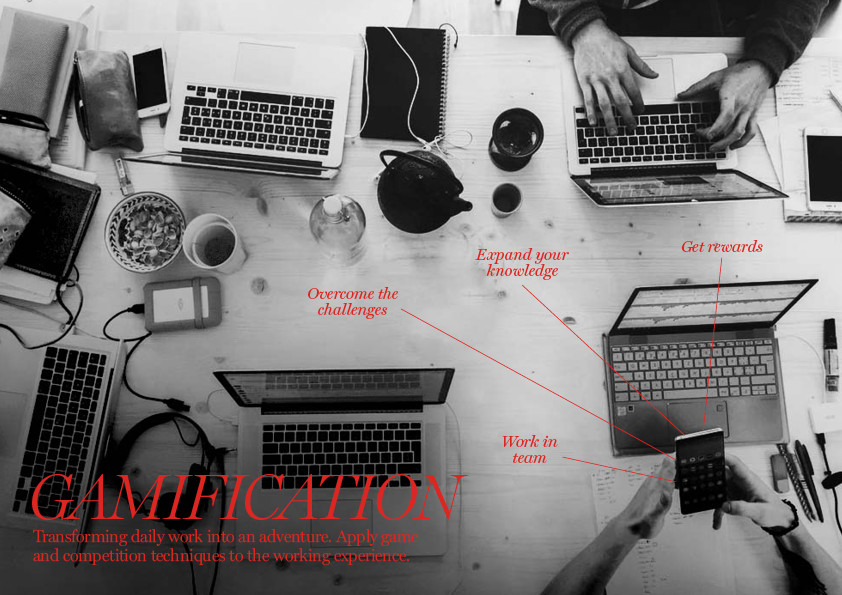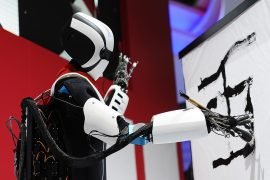[dropcap letter=”G”]
amifying means transforming day-to-day work into an adventure. It means applying playing and competition techniques to a working environment, adhering a layer of fiction to reality in order to increase motivation in those who experience it. The work does not change: only the way you relate to it. The daily effort, run of the mill, becomes an opportunity to show everyone how well you work, and incidentally, receive one or several awards for doing it, all in a fictional story in which you and your co-workers are the stars. With the help of technology, gamification lets you turn monotonous professional tasks into fun, lonely work into a collective challenge, individual success into public recognition. Everything with a single purpose: to motivate people to get the best out of themselves in their professional activity.
 “Gamification is the incentive of the 21st century,” says Lluís Costa, a Business Partner Manager at multinational foods and pet-care company Mars Iberia. The Spanish section of the company—which has been implementing gamification projects with its delegates for 4 years—achieved a 6% increase in sales and an 11% increase at year-end. Now they are running 125 games. “For me, gamification is part of all that accumulation of things that a company has to do to attract and retain the best talent and make them feel adequately rewarded,” adds Costa. Mars is not the only multinational that is now committed to gamification. 70% of the companies that make up the Forbes Global 2000 list use or have used this technique in some of their processes. In Spain, large corporations like Danone or Gallina Blanca also use gamification to improve.
“Gamification is the incentive of the 21st century,” says Lluís Costa, a Business Partner Manager at multinational foods and pet-care company Mars Iberia. The Spanish section of the company—which has been implementing gamification projects with its delegates for 4 years—achieved a 6% increase in sales and an 11% increase at year-end. Now they are running 125 games. “For me, gamification is part of all that accumulation of things that a company has to do to attract and retain the best talent and make them feel adequately rewarded,” adds Costa. Mars is not the only multinational that is now committed to gamification. 70% of the companies that make up the Forbes Global 2000 list use or have used this technique in some of their processes. In Spain, large corporations like Danone or Gallina Blanca also use gamification to improve.
DIGITAL TRANSFORMATION: A CHANGE OF PARADIGM
It is not a question of a technological trend, but a change in business culture. That is what the digital transformation everyone is talking about is: redesigning the internal dynamics of organizations, reinventing them from the point of view of technology and innovation. Transforming digitally requires stopping the machinery and looking at ourselves in the mirror, putting each one of the professional dynamics of the organization under the looking-glass and to ascertain how the present and future of digital technology can help enhance it. The objective: to be more efficient, more profitable, and more sustainable over time, but also more relevant for people who work or interact with the company. Improving from within and inward, to be able to do better outwardly too.
Gamification is a digital tool, which through technology places professional teams at the centre of the equation. In one way or another, it makes them the protagonists again. The combination of elements such as healthy competition between colleagues; the potential of receiving awards for doing your job well, and objective public recognition for the achievements can increase employee engagement by up to 30%, a change that makes an effective difference. According to Gallup’s State of the Global Workplace 2017 report, the improvement in employee engagement increases their productivity by up to 17%, which translates as sales growth of 20% and improvements of 21% of the overall profitability of the company.
HOW IS GAMIFICATION DONE?
Joan Trilla, the CEO of Barcelona start-up Playmotiv, which specializes in sales force gamification, explains: “The first thing you need to do is to really get know the client and their needs. Understand their objectives, their working methods, and above all the type of players that will participate in the game. In this way we can create a story as you connect emotionally with them.” Once the game is set up on the technological platform they have developed, the adventure is launched and the players interact with it through an app. At any time, from your mobile, you can check progress in relation to the different indicators determined by your company, doing so within the context of a fiction. They can check their achievements, compare them with those of others, and find and manage their own awards. When the game ends, the client and the gamifier compare their data—participation, improvement in performance, feedback from the players…—and analyse the results in order to extract the “lessons learned,” as per their jargon.
According to Trilla, the most relevant point is, however, the return on investment. “In the end, the fact you heave sold more while gamification lasts does not necessarily mean that you have done well. You have to analyse the data in context, compare it with the effort you have made to start the game,” explains Playmotiv’s CEO. And does it work? “That’s what the results tell us. If you have invested 20 and you get 40, the game has been profitable. But if you get 2,800 from investing that same amount, it has been a runaway success. We have seen that kind of ROI in our clients’ results, so we know that our gamification works.”



















